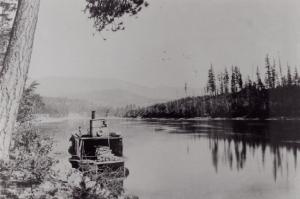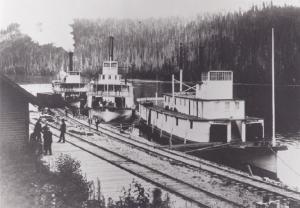
STEAMSHIPS ON THE COLUMBIA
In 1866 the stern-wheeler "Forty-Nine" started regular service, carrying thousands of paying passengers to the Big Bend gold fields. Captain White proved that the Columbia could be navigated to the foot of Death Rapids. Other steamships followed, hauling in addition to passengers, supplies for railway construction and mining camps. For almost 100 years, these ships were a lifeline to the isolated communities along the Columbia and the Arrow Lakes.
The solitude of the Columbia valley was rudely broken on a December day in 1865 when a steam-driven paddle wheeler appeared from the south, chugging its way upriver. It was the American ship "Forty-Nine", which had been launched at Marcus, Washington "by the light of some candles, and fitful glimpses of the polar star". It was built for service on the Columbia from Marcus to La Porte, at the foot of Death Rapids. La Porte was a community which grew to service the placer mines along tributaries of the Goldstream River, a few kilometers to the north. During the inaugural voyage, the "Forty-Nine " could not make her way through the ice in the Narrows between the two Arrow Lakes, and her passengers had to reach the gold-fields on foot. During the next season, however, Captain Leonard White was successful in tackling the imposing rapids of the Columbia and reaching La Porte. His policy was to charge his passengers full fare on the upstream journey, and to allow poor miners free passage back out to civilization "if they were truly broke". Unfortunately, the gold deposits of the Big Bend were soon exhausted, and late in 1866, on his third voyage of the year Captain White had only three paying passengers. Although business to La Porte dwindled, other gold strikes such as the one on Forty-nine Creek near Nelson allowed a continuation of service until the steamer ran aground below Downie Creek in 1869. She was patched up and continued intermittent service when there was a demand, such as supplying Walter Moberly's survey party through the Selkirks in November 1871.
With the completion of the C.P.R. mainline, the picture was significantly altered. It now became possible to run a scheduled service from Revelstoke to Little Dalles, essentially in reverse direction from the first two ventures. The challenge was accepted by Fred Hume and Robert Sanderson who took on an additional partner and in 1888 launched a small twin-hulled vessel named the "Despatch" . She left Revelstoke on her inaugural run on August 8, 1888, and reached Sproat's Landing (the access point to the Silver King claim) two days later. It quickly became obvious that her design imposed limitations of speed and hauling capacity. Sproat's Landing was named after Tom Sproat who started farming on the site, having preempted 310 acres on May 28th of the same year. The following year, we find G.M.Dawson doing surveys in the area and booking passage upriver on the boat on July 9th.
The three partners of the Columbia Transportation Company had by now realized that they could only meet the ever increasing demand by the infusion of additional capital, and thus three additional partners were added and the expanded venture was renamed the Columbia and Kootenay Steam Navigation Company. It was incorporated on January 21, 1890 with capital resources of $ 100,000. Immediately, they commissioned the construction of a much larger and more luxurious vessel, the "Lytton" for $ 38,000. Another $ 10,000 was spent in purchasing the idle "Kootenai" and immediately putting her back into service. The "Lytton" left Revelstoke on July 3, 1890 on her maiden run. Amongst the dignitaries on board was William van Horne, journeying to Sproat's Landing to check on the progress of the Columbia and Kootenay Railway which was inching its way towards Nelson. They arrived at the Landing on July 4th, finding a bustling community which included a government building, railway buildings, sawmill, two stores, at least one hotel, three restaurants, and several houses. On August 15th, Corbin's railway from Spokane to Northport commenced operations and connections were worked out with the C.K.S.N. steamers.
All things, however, were not going well. On August 2, 1894 the luxurious "Columbia" caught on fire south of Trail and was quickly reduced to a total loss, only three years after her initial run. Plans were made for a replacement, and an even more stately vessel, the "Nakusp" was launched on July 1, 1895. Later that year, the "Kootenai" grounded on Upper Arrow Lake and was written off. On June 11, 1896, her replacement the "Trail" started service.

|
 |
By this time Augustus Heinze had completed his Columbia and Western rail line to Robson West. In a dramatic move, C.P.R. bought out his railway as well as the smelting operation in Trail for $ 860,000. They immediately implemented a barging service between Robson and Robson West so that Crowsnest coal could be hauled to Trail by rail. The "Illecillewaet" and "Lytton" were kept busy at this service until it was replaced by a bridge in 1902.
 |
 |
The "Minto", like her sister ships, represented a way of life and a set of values which appear to be at odds with our super-efficient, profit-motivated society. The ships were built to a standard of luxury which would be hard to justify in the competitive world of today. The meals served on board were far superior to today's standard fare and they were affordable to all. Great pride was taken in providing a homely atmosphere and the schedules were flexible enough to allow for adventures:
" On Saturday morning as the MINTO, with Captain Lyman Fraser in command, was approaching Fire Valley, watchman Douglas saw two gigantic eagles circling around a tree on the west bank. He called the attention of the Captain, and every available fire-arm was used: the Captain, Mate and Purser, Baptiste, who was the hero of the last eagle battle, and several others taking part. The first successful shot was made by the Pilot, who brought down the female bird. The male bird disappeared but Mate McCarthy put on climbers and got up the 70 ft. tree about 30 ft. when he slipped and fell to the ground, but was not injured. Asst. Engineer Swan Peterson then tried, and succeeded in reaching the nest. There he found a young bird which he threw down and it was captured uninjured. Peterson's descent was the most exciting feature of the whole adventure. When 50 ft. from the ground, his strength gave out. At that height the girth of the tree was too great to encircle with his arms so he remained there, helpless. As soon as his danger was recognized, all the MINTO's ladders were lashed together end to end and placed against the tree. From the top, one of the crew succeeded in throwing a rope to Peterson, who made it fast over a short branch. He then slid down the rope and was assisted to the top of the ladder and then to the ground, exhausted but unhurt."
- Revelstoke Herald, July 6th, 1905.
Another newspaper article, written before C.P.R. took over the fleet, projects us back into that seemingly too-distant time:
" To ride on the steamer COLUMBIA, from Nakusp to Robson, when the sun is shining and a gentle breeze flip flaps the curtains in the staterooms is a pleasure deliciously delightful.
The officers are courteous, obliging, and handsome. Steward Thompkins knows how to cater to the inner man, while Purser Anderson's winning ways cause the lonely tenderfeet to think they own the boat. Up in the pilot house, we found Captain Gore twirling the wheel, first one way, then the other, as the occasion demanded. In conversation with him, we increase our stock of navigation knowledge."
- Nakusp Ledge, June 7th 1894.
If only we could step on board again.
All rights reserved. Information is provided for personal use only. Use in any other application without permission is forbidden.



